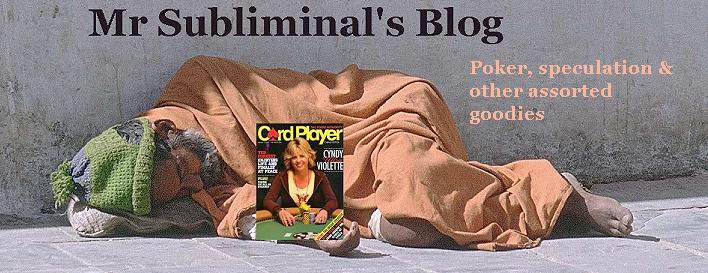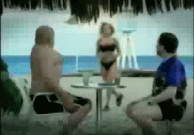Many poker players come from trading backgrounds - Chris Ferguson, Alan Goehring, Erik Seidel to name but a few. For those interested, following is a list I compiled comparing a trade to a hand of poker.
Similarities between a trade and a hand of poker
(1) The outcome of each is uncertain.
(2) Both are zero sum games, ignoring commissions, rake etc. (Assume futures)
(3) At any time, a trader may elect to stay out of the market, and a player may elect to stay out of a hand, at no cost. (Blinds, antes, like software and DSL costs, are assumed to be running expenses. Or alternatively, the player may elect to leave the table.)
(4) It is possible for both trader and player to benefit from information gleaned about his opponents.
Differences between a trade and a hand of poker
(1) In a trade, the opponents and their numbers are unknown. In a hand of poker, the opponents and their numbers are known.
(2) Once a trade is initiated, a trader can do nothing more to influence the outcome of that particular trade, unlike a player who, because of the betting structure, may influence the actions of other players and hence the outcome of the hand.
(3) A trade, once initiated, may be closed out at any time only by the trader. A hand of poker, once initiated, may be prematurely completed by the action of the player eg. he folds, or by the action of others eg. everyone else folds.
(4) Unlike a trade, a hand of poker has a fixed, predefined length.
(5) A trade may be "prematurely" closed for either a profit or loss by the trader. A player can only prematurely complete a hand for a loss.
(6) At all times during a trade, the P&L is uniquely and unambiguously defined. At all times during a hand, the player's equity in the pot can only be subjectively estimated using incomplete information (in most instances).
(7) As a corollary to (6) above, the intra-trade equity curve is generally smooth and continuous, while the intra-hand equity curve is jumpy and discrete.
(8) As a corollary to (7) above, a player will encounter many "bad beats" with their accompanying psychological pain. A trader will rarely see profits snatched away from him so suddenly; his pain is of a more gradually built-up nature.
(9) A trader may predefine profit target and stop loss. A player will have different losses and profits depending on the particular hand. In fact optimal play negates the notion of a stop loss.
Wednesday, December 29, 2004
Trading vs. Poker
Posted by
Mr Subliminal
at
2:03 PM
0
comments
![]()
Monday, December 27, 2004
Finnish Finish
Bellagio $2-$5 NLHE Saturday night, the place is packed. I'm in a fairly good game and am dealt Q♠ Q♣ in the small blind. 3 limpers, I call, BB checks. 5 players see the flop which is
J♠ Q♦ J♥
Check-check-check-check-check.
Turn : 3♠
I check, BB checks, EP player with $300 stack bets $30, MP folds, LP with $100 stack goes all-in, I call (my stack is $350), BB folds, EP goes all-in, I call.
EP turns over 3♦ 3♥, LP shows J♠ 4♠. I am 95% favorite and it seems that only the mere formality of the river prevents the lovely Finnish dealer Sirpa from pushing me a $725 pot.
I shout "Not a 3! Not a 3!" as the river card is dealt.
River : 3♣
Sirpa's normally Finnish white complexion turns whiter, her eyes refusing to meet mine. I just sit there stunned. I get the usual condolences from the other players ("man that was brutal", "what a bad beat") and the game continues. I buy in for another $200 and play my usual solid game - absolutely no tilting, though the self-pitying feeling does linger for a while. I mentally vow never to tip Sirpa again for the rest of my life, but will first broach this subject with my coach Tommy who has helped me with all sorts of issues.
An hour later I leave the game up $135. Five hours later I am still thinking about the hand.
Posted by
Mr Subliminal
at
1:50 AM
0
comments
![]()
Wednesday, December 22, 2004
A Plan
No Limit (NL) Hold'em (HE) cash games seem to be sprouting everywhere here in Vegas. Rather than describe the varied characters and hands of a particular session (which will come eventually), let me start off with my Poker Plan. Every serious poker player should have a written Poker Plan. That's the easy part. The hard part is rigidly adhering to it. Following are excerpts from mine - for strategic reasons some parts are omitted or incomplete, but this is not important. What is important is that you formulate some logical guidelines and stick with them.
(a) $2-$5 NLHE $200 minimum/maximum buy-in (Bellagio)
(b) $2-$4 NLHE $200 minimum/maximum buy-in (Mandalay Bay)
(c) $2-$5 NLHE $100 minimum $500 maximum buy-in (Palms)
(d) $2-$5 NLHE $200 minimum $500 maximum buy-in (Mirage)
The above list is not exhaustive and is based on a bankroll of at least $5,000.
Length of Session
A playing session shall consist of two 3 hour periods separated by a 30-45 minute break for eating and rest. Under no circumstances should play exceed 6 hours.
Money Management
(1) It is imperative that all play is within strict bankroll requirements, which in this case means that the playing bankroll should cover at least 25 buy-ins. So for the Mirage and Palms games, buy-ins for $500 should only be considered if the bankroll is at least $12,500 (with the same principle applying to other amounts).
(2) A session shall be immediately terminated once 3 buy-ins are lost.
Playing Rules and Strategies
(a) A pot is only to be opened with .............
.....
.....
(g) Take a short break after a bad beat.
.....
.....
(i) As mentioned above, a session shall not exceed 6 playing hours.
.....
.....
Miscellaneous
(1) A playing log will be maintained daily in an Excel spreadsheet.
(2) This Poker Plan is a work in progress to be modified continually.
Posted by
Mr Subliminal
at
11:23 PM
0
comments
![]()
Tuesday, December 21, 2004
Inside Looking Out
Sittin' here lonely like a broken man
Servin' my time doin' the best I can
Walls and bars they surround me
But I don't want your sympathy
(Inside Looking Out - Animals)
Posted by
Mr Subliminal
at
10:05 PM
![]()



